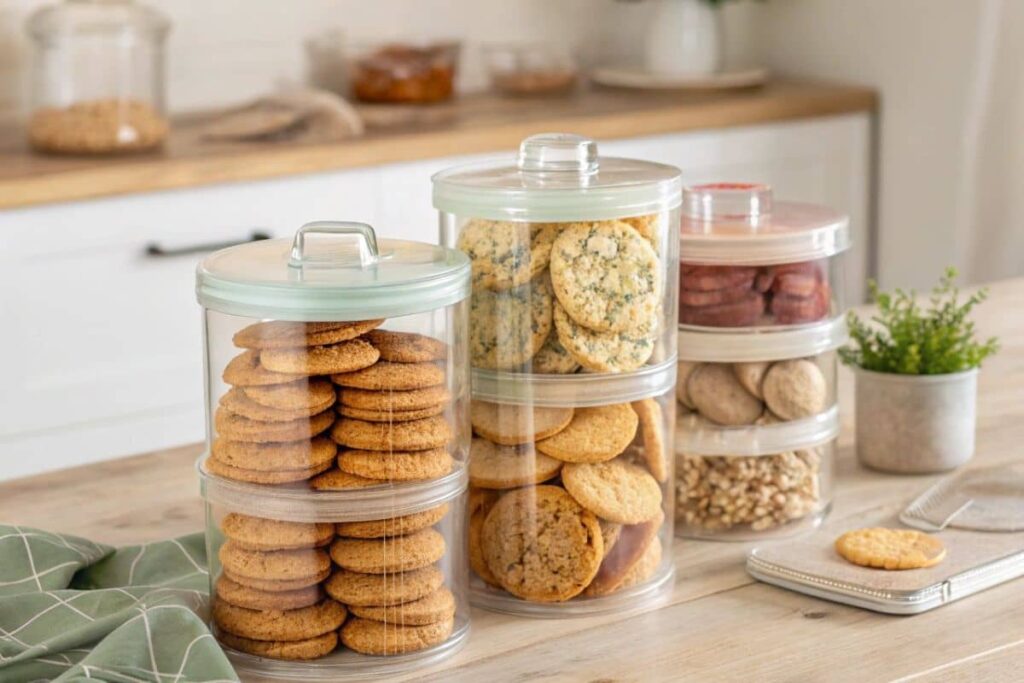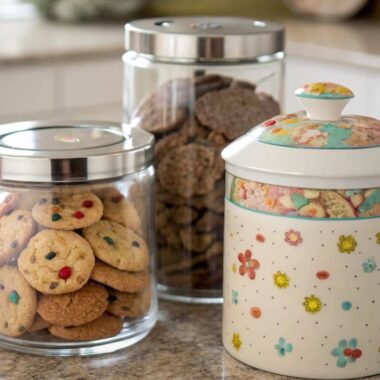Crumble cookies, with their perfect balance of crisp edges and soft centers, deserve to be enjoyed at their absolute best. But once these irresistible treats make it home (or emerge warm from your oven), the freshness countdown begins!
Here’s the good news: with the right storage tricks, you can keep these cookies tasting amazing for days or even weeks. The difference between a cookie that stays deliciously fresh and one that turns disappointing is all about how you store it.
In this guide, I’ll share my tried-and-true methods for preserving your crumble cookies’ just-baked quality, from simple countertop solutions to freezer techniques that lock in all that flavor and texture. Let’s make sure every single bite stays as delicious as the first!

Best Practices for Storing Different Types of Crumble Cookies
Crumble cookies come in a variety of textures and flavors—soft, chewy, crispy, or decorated. Each type requires specific care to preserve its unique qualities. Follow these simple tips to ensure your cookies stay fresh and delicious.
1. Soft and Chewy Cookies
Soft cookies need moisture to maintain their signature texture. Without proper storage, they can dry out and lose their chewiness.
- How to Store: Use an airtight container lined with parchment paper. Stack cookies in a single layer or separate layers with parchment to prevent sticking.
- Extra Tip: Add a slice of bread or a small piece of apple to the container. This keeps cookies moist, as they absorb the humidity from the bread or fruit.
- Shelf Life: 5 days at room temperature; longer if refrigerated.
2. Crispy Cookies
Crispy cookies are all about the crunch. Exposure to moisture can make them soft and lose their crispiness.
- How to Store: Use an airtight container with a silica gel packet or a paper towel to absorb extra moisture. Avoid refrigerating, as the cold air can introduce humidity.
- Keep Them Dry: Always let cookies cool completely before storing. Warm cookies trap steam, ruining their crunch.
- Shelf Life: 7 days at room temperature.
3. Frosted or Decorated Cookies
Cookies with frosting, glazes, or decorations require special care to protect their appearance.
- How to Store: Place cookies in a shallow airtight container in a single layer. If stacking is necessary, use wax or parchment paper between layers to avoid smudging.
- Refrigeration: If the frosting includes dairy or cream, store the cookies in the fridge. Let them return to room temperature before serving for the best taste and texture.
- Shelf Life: 2-3 days at room temperature; up to a week in the fridge.
4. Gluten-Free or Specialty Cookies
Gluten-free cookies often use alternative flours, which can dry out faster than traditional recipes.
- How to Store: Keep them in an airtight container at room temperature. Avoid refrigeration, as it can dry them out. For long-term storage, freeze them.
- Extra Tip: If the recipe includes unique ingredients like almond or coconut flour, follow any specific storage recommendations.
- Shelf Life: 3-4 days at room temperature; up to 2 months in the freezer.
5. Homemade vs. Store-Bought Cookies
- Homemade Cookies: Without preservatives, homemade cookies have a shorter shelf life. Store them in an airtight container and eat within a week for the best flavor.
- Store-Bought Cookies: These often last longer due to preservatives. Once opened, transfer them to an airtight container to maintain freshness.
Pro Tip: Separate Different Types of Cookies
Mixing soft and crispy cookies can ruin both textures. Store each type in its own container to maintain their distinct characteristics.

Storing Crumble Cookies
Crumble cookies are a favorite for many, but keeping them fresh and delicious can raise questions. Below are detailed answers to the most common concerns about storing and preserving these delightful treats.
1. How Long Do Crumble Cookies Stay Fresh?
The shelf life of crumble cookies depends on how they are stored:
- At room temperature: When stored in an airtight container, cookies can stay fresh for 3-5 days.
- In the fridge: They can last up to a week, though refrigeration may cause some types, especially crispy cookies, to lose their texture.
- In the freezer: Properly frozen cookies can remain fresh for up to 2 months without losing their flavor or structure.
Tip: For best results, consume cookies within the recommended timeframe, as even the best storage methods can’t entirely prevent gradual texture changes.
2. What Is the Best Way to Store Cookies to Maintain Freshness?
The best storage method depends on the type of cookie:
- Soft or chewy cookies: Store in airtight containers with a slice of bread to retain moisture.
- Crispy cookies: Use airtight containers with a paper towel or silica gel packet to absorb excess humidity.
- Frosted or decorated cookies: Place them in a single layer in a shallow airtight container to protect their designs. If you need to stack them, separate layers with parchment paper.
Regardless of type, ensure cookies are fully cooled before sealing them to prevent condensation.
3. Can You Freeze Crumble Cookies?
Yes, crumble cookies freeze exceptionally well and freezing is an excellent way to extend their shelf life:
- How to Freeze: Wrap each cookie in plastic wrap or parchment paper, then place them in a freezer-safe bag or container. Label the package with the date for easy tracking.
- Thawing: To enjoy frozen cookies, remove them from the freezer and let them thaw at room temperature for 1-2 hours. Avoid microwaving frozen cookies, as it can affect their texture.
Tip: For cookies with delicate toppings, like frosting or sprinkles, freeze them unfrosted and add decorations after thawing.
4.How to Keep Soft Cookies from Going Stale
To maintain the moisture and chewiness of soft cookies, proper storage is key. Add a slice of bread or a small piece of apple to the container, as the cookies will absorb their humidity without altering the taste. For extra protection, double-wrap cookies individually before placing them in an airtight container.
If you’re interested in learning more about keeping baked goods soft and moist, check out our guide on What Is the Secret to Moist Muffins. The principles shared there can help enhance your cookies as well!
5. Can I Store Different Types of Cookies Together?
It’s not recommended to mix different types of cookies in the same container. This can lead to texture and flavor issues:
- Soft cookies: They may transfer moisture to crispy cookies, causing both to lose their ideal textures.
- Strongly flavored cookies: Flavors like ginger or mint can transfer to milder cookies if stored together, creating unwanted taste combinations.
Solution: Use separate containers for each type of cookie to maintain their unique textures and flavors.
6. Should I Refrigerate Frosted or Decorated Cookies?
Refrigeration depends on the type of frosting or decoration:
- Dairy-based frostings (like cream cheese or whipped cream): These cookies should always be refrigerated to prevent spoilage. Store them in a shallow container to avoid smudging the frosting.
- Buttercream or sugar glaze: These cookies can typically be stored at room temperature in an airtight container.
If refrigeration is necessary, allow cookies to return to room temperature before serving to restore their original taste and texture.
7. How Do I Revive Stale Cookies?
Stale cookies don’t need to be thrown away. Here are ways to bring them back to life:
- For soft cookies: Wrap the cookie in a damp paper towel and microwave it for 10-15 seconds. The steam will rehydrate the cookie, making it soft again.
- For crispy cookies: Place them in a preheated oven at 300°F (150°C) for 3-5 minutes. This restores their crunch by evaporating excess moisture.
- For frosted cookies: Avoid reheating them directly. Instead, scrape off the frosting, revive the cookie as needed, and reapply fresh frosting.
8. How Can I Tell if Cookies Have Gone Bad?
Cookies that are past their prime may show these signs:
- Dryness: Cookies become overly hard or crumbly.
- Off taste or smell: Spoiled cookies may have a stale or unpleasant flavor and aroma.
- Mold: If stored in a humid environment for too long, cookies can develop mold—this is a clear sign they should be discarded.
Pro Tip: Always inspect cookies for these signs before consuming them, especially if they’ve been stored for more than a week.
9. Can I Store Homemade and Store-Bought Cookies Together?
It’s best to store them separately. Store-bought cookies often contain preservatives that help them stay fresh longer, while homemade cookies typically lack these additives. Storing them together can cause uneven freshness and might alter the texture or flavor of your homemade batch.
Recap of Key Strategies for Cookie Freshness
- Understanding the Science of Freshness: Knowing how cookies lose or absorb moisture helps you choose the best storage solutions for each type of cookie.
- Selecting Proper Storage Containers: Airtight containers, resealable plastic bags, or food wraps help minimize exposure to air and preserve cookies’ textures, whether they’re soft, chewy, or crispy.
- Tailoring Storage to Cookie Types: Soft cookies thrive in moist conditions, while crispy cookies need a dry environment. Frosted and decorated cookies require extra care to protect their appearance.
- Freezing for Long-Term Enjoyment: Properly freezing cookies in sealed containers ensures they stay fresh for up to two months, making it easy to enjoy your treats later.
- Reviving Stale Cookies: Simple tricks like microwaving soft cookies or reheating crispy ones in the oven can bring them back to life when they lose their texture.
Why Proper Storage Matters
Good storage practices not only keep your cookies tasting fresh but also maintain their appearance and texture. Whether you’re saving homemade cookies for a special occasion or want to savor a batch of store-bought ones over time, the right approach makes all the difference.
When you understand the needs of each cookie type, you can avoid common mistakes—like mixing soft and crispy cookies in the same container, refrigerating unnecessarily, or leaving cookies exposed to air. Instead, you can take simple, effective steps to extend their freshness while enjoying their original quality.
Cookies for Every Occasion
Properly stored cookies are more than just a snack—they’re a delightful way to celebrate special moments or enjoy a quiet indulgence. Having a stash of perfectly fresh cookies on hand is always a win, whether for guests, family, or yourself.
Even for long-term storage, freezing cookies allows you to bake in advance and enjoy homemade goodness whenever you’re ready. Plus, reviving cookies that have started to go stale ensures no crumb is wasted. With these tips, your crumble cookies will always be ready to impress.

Crumble cookies are a simple pleasure that can be enjoyed any time of the year. By following the right storage techniques, you ensure their flavors and textures remain as delightful as the day they were made. If you’re wondering what makes a cookie crumble, understanding the balance of ingredients and proper care is key to preserving their texture.
Whether chewy, crispy, or frosted, each cookie deserves the care to stay perfect for as long as possible. Curious about what is the secret to a crunchy cookie? It’s all about the right baking techniques and how you store them afterward.
So, take the time to store your cookies well and enjoy every last bite—fresh, flavorful, and just as good as when they first came out of the oven. For more inspiration, explore the joy of cookie crumble and make your treats last longer!

Crumble Cookies Storage Guide
Instructions
Storage Techniques
- For Soft and Chewy Cookies: Use an airtight container lined with parchment paper and add a slice of bread or a small piece of apple for moisture. Shelf life is 5 days at room temperature.
- For Crispy Cookies: Store in an airtight container with a silica gel packet or paper towel to absorb moisture. Shelf life is 7 days at room temperature.
- For Frosted Cookies: Place in a shallow airtight container in a single layer. Refrigerate if the frosting contains dairy. Shelf life is 2-3 days at room temperature or up to a week in the fridge.
- For Gluten-Free Cookies: Store in an airtight container at room temperature or freeze for long-term storage. Shelf life is 3-4 days at room temperature or up to 2 months in the freezer.
- For Homemade Cookies: Store in an airtight container and consume within a week.
- For Store-Bought Cookies: Transfer to an airtight container once opened to maintain freshness.
- Avoid mixing different types of cookies in the same container to preserve their unique textures.
Reviving Cookies
- To revive soft cookies, wrap in a damp paper towel and microwave for 10-15 seconds.
- For crispy cookies, reheat in a preheated oven at 300°F (150°C) for 3-5 minutes.
- For frosted cookies, scrape off frosting, revive the cookie, and reapply fresh frosting.





